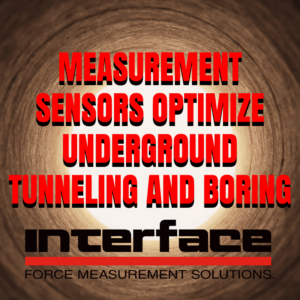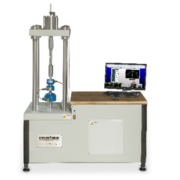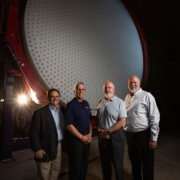Measurement Sensors Optimize Underground Tunneling and Boring
 Tunnel boring has existed since the earliest human civilizations, a major underpinning of the world’s infrastructural history. However, with today’s technology, the method of boring tunnels has changed drastically.
Tunnel boring has existed since the earliest human civilizations, a major underpinning of the world’s infrastructural history. However, with today’s technology, the method of boring tunnels has changed drastically.
Natural resource boring, digging, and tunneling projects frequently involve civil engineering and construction companies. They handle a wide range of infrastructure projects requiring tunnels, including transportation systems such as subways, high-speed rail tunnels, road underpasses, and utility tunnels for water, sewage, and power lines.
Boring and tunnel projects are part of government infrastructure programs worldwide. These agencies contract and purchase boring machines for public infrastructure projects such as flood control and water treatment systems that need to be accessed below ground. Mining companies frequently use boring equipment to access tunnels to reach mineral deposits.
Tunnel boring is the process of excavating tunnels through a variety of natural materials, including soil, rock, and even beneath bodies of water. These underground pathways are instrumental in facilitating transportation, utility delivery, and infrastructure development.
Tunnel boring is a form of construction that involves digging a large tube-like passage through the earth. It can also be referred to as “mountain tunneling,” where excavation of these tunnels is conducted using a Tunnel Boring Machine (TBM).
Primary Purposes for Using Sensor Technologies in Tunnel Boring Machines and Equipment
Efficiency: It allows for faster and more controlled excavation compared to traditional methods like drilling and blasting.
Accuracy: TBMs can create smooth tunnels with minimal deviation, reducing the need for additional wall work.
Safety: Boring machines minimize ground disruption and vibrations, making them safer for urban environments and workers compared to blasting.
Reduced Environmental Impact: Controlled excavation produces less dust, noise, and debris than traditional methods.
Interface Measurement Solutions for Tunnels, Boring, and Excavation
Tunnel Boring Machine (TBM) Performance: TBMs are designed to cut through rock and soil with a rotating cutter head. The torque of the cutting wheel needs to be monitored and tested to ensure it is working properly during excavation operations. Interface’s T2 Ultra Precision Shaft Style Rotary Torque Transducers are attached to the cutter drives of the cutting wheel used to cut through the material. When connected to the BX8-AS BlueDAQ Series Data Acquisition System the customer can monitor the torque of the cutting wheel mechanism of the TBM when connected to the customer’s computer with supplied BlueDAQ software. Interface multi-axis sensors can also monitor the real-time position and orientation of the TBM cutter head. This data is used to control the machine’s steering and ensure accurate tunnel excavation.
Machine control and automation: Load cells, torque transducers, and multi-axis sensors provide data that can be used to automate various functions of boring, tunneling, and earthmoving machines. For example, they can be used to control the bucket-filling process or the directional control of a TBM.
Spoil pile management: Load cells can weigh trucks transporting excavated material. This data is used for billing purposes and to ensure compliance with weight limits.
Safety systems: Load cells and torque transducers can be used as part of safety systems for boring, tunneling, and earthmoving machines. They can prevent overloading or shut down the machine if a potential hazard is detected.
Data collection for performance optimization: The data collected from load cells, torque transducers, and multi-axis sensors can be used to analyze machine performance and identify areas for improvement. This data can also be used to develop more efficient and productive boring, tunneling, and earthmoving methods.
Monitoring pile driving force: Load cells monitor the force exerted by the hammer during pile driving operations. This data is crucial for ensuring the piles are driven to the proper depth and capacity.
Monitoring excavator bucket load: Load cells can be integrated into excavator buckets to monitor the weight of the material being dug. This information can be used to optimize excavator productivity and prevent overloading.
Monitoring drilling rig thrust and torque: Load cells and torque transducers monitor drilling rig thrust and torque. This data is essential for ensuring proper drilling performance and preventing damage to the drill string.
Interface load cells can be strategically embedded within tunnel boring machines (TBMs) and accurately measure the forces exerted during excavation. Torque transducers can measure reaction or rotational forces on equipment components to ensure tools and machines operate properly. Multi-axis sensors are useful in gathering data in X, Y and Z axes to build deeper profiles of operational processes, especially related to automation and structural use cases. Additionally, Interface load pins and load links are used in boring operations for equipment that needs safety and overload monitoring.
Interface sensor technologies are a critical component of tunnel boring operations. By monitoring parameters like torque, thrust, and pressure, these sensors provide real-time feedback to operators. This enables them to make adjustments that optimize performance and mitigate risks. Whether it’s navigating through challenging geological formations or maintaining stability in dynamic conditions, force sensors are instrumental in upholding the integrity and efficiency of tunnel boring operations, underscoring their pivotal role in the advancement of underground infrastructure.
Contact our application engineers for specific recommendations on sensors, instrumentation, accessories, enclosures, and complete measurement systems.








